 Website:
SunTech Medical
Website:
SunTech Medical
Group: SciCan
Catalog excerpts

VITAL SIGNS MONITOR AH systems nominal NI8P: SYS/DIA mmH# : Jane Smith Female 30 Adult H: 160cm w: 50kg
Open the catalog to page 1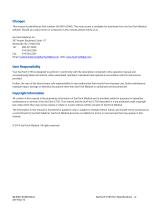
Changes This manual is identified as Part number: 80-0081-00-MO. The most recent is available for download from the SunTech Medical website. Should you notice errors or omissions in this manual, please notify us at: SunTech Medical, Inc. 507 Airport Boulevard, Suite 117 Morrisville, NC 27560 USA Tel: 800.421.8626 919.654.2300 Fax: 919.654.2301 Email: CustomerService@SunTechMed.com Web: www.SunTechMed.com User Responsibility Your SunTech CT50 is designed to perform in conformity with the description contained in this operation manual and accompanying labels and inserts, when assembled,...
Open the catalog to page 2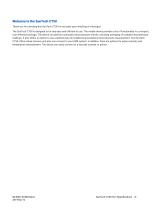
Welcome to the SunTech CT50 Thank you for choosing this SunTech CT50 for accurate spot checking of vital signs. The SunTech CT50 is designed to be very easy and efficient to use. The mobile device provides a lot of functionality in a compact, cost-effective package. The device can perform automatic blood pressure checks, including averaging of multiple blood pressure readings. It also offers an option to use a stethoscope for traditional auscultatory blood pressure measurement. The SunTech CT50 offers robust memory and also can connect to your EMR system. In addition, there are options for...
Open the catalog to page 3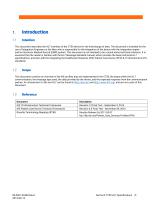
Introduction 1.1 Intention This document describes the HL7 interface of the CT50 device for the interchange of data. The document is intended for the use of Integration Engineers or the likes who is responsible for the integration of the device with the integration engine and/or Electronic Medical Record (EMR) system. This document is not intended to be a stand-alone technical reference. It is assumed that the reader is familiar with the HL7 Message Standard manual, which provides the basic technical HL7 specifications, and also with the Integrating the Healthcare Enterprise (IHE) Patient...
Open the catalog to page 5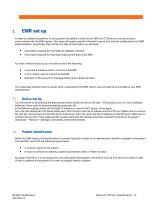
In order to validate the patient's ID and populate the patient's vitals into an EMR, the CT50 device must be set up to communicate with the EMR system. This setup will require specific information about your network configuration and EMR implementation. Specifically, there will be two sets of information you will need: Information required for the Patient ID validation function Information required for reporting measurement data to the EMR. For both of these functions, you will need to know the following: A network IP address used to connect to the EMR. A port number used to connect to the...
Open the catalog to page 6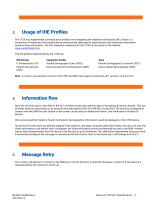
3. Usage of IHE Profiles The CT50 has implemented communication profiles from Integrating the Healthcare Enterprise (IHE), which is a consortium of healthcare and medical device professionals dedicated to improving the way healthcare information systems share information. The IHE integration statement for the CT50 can be found on the website www.suntechmed.com. The IHE profiles implemented by the CT50 are: IHE Domain Integration Profile Actor IT Infrastructure (ITI) Patient Demographic Query (PDQ) Patient Demographics Consumer (PDC) Patient Care Devices Device Enterprise Communication (DEC)...
Open the catalog to page 7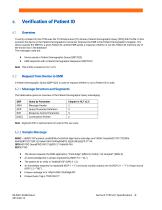
Verification of Patient ID 6.1 Overview To verify a Patient ID, the CT50 uses the IT Infrastructure (ITI) domain, Patient Demographic Query (PDQ) IHE Profile. In this scenario the device is the Patient Demographics Consumer whereas the EMR is the Patient Demographics Supplier. The device queries the EMR for a given Patient ID, andthe EMR sends a response whether or not the Patient ID matches any of the known IDs in the database. The messages used are: • Device sends a Patient Demographic Query (QBPAQ22) • EMR responds with a Patient Demographic Response (RSPAK22) Note: This profile is based...
Open the catalog to page 8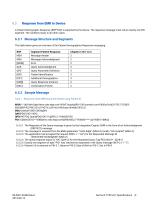
A Patient Demographic Response (RSPAK22) is expected by the device. The response message must return exactly one PID segment. The workflow stops in all other cases. 6.3.1 Message Structure and Segments The table below gives an overview of the Patient Demographics Response messaging: 6.3.2 Sample Message Case 1: Response when EMR found the Patient using Patient ID MSH|A~\&|VistA-EdgeAdemo.vista-edge.comAURI|VE Hospital|RSV-100Asuntech.comAURI|SunTech|20170127155803-0600||RSPAK22ARSP_K21|c974279c-2cf6-4cc9-98ef-aaec1d44d0a7|P|2.5| MSA|AA|xRy6Yri3KE1 C6404gE4N QAK|PDQ104211|OK| QPD|IHE PDQ...
Open the catalog to page 9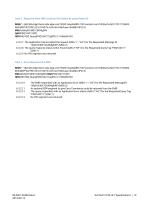
Case 2 : Response when EMR could not find Patient by using Patient ID MSH|^~\&|VistA-Edge^demo.vista-edge.com^URI|VE Hospital|RSV-100^suntech.com^URI|SunTech|201701271558030600||RSP^K22^RSP_K21|c974279c-2cf6-4cc9-98ef-aaec1d44d0a7|P|2.5| MSA|AA|xRy6Yri3KE1C6404gE4N QAK|PDQ104211|NF| QPD|IHE PDQ Query|PDQ104211|@PID.3.1^666656765 6.3.2.7 The application had accepted the request (MSA-1 = “AA”) for the Requested Message ID "xRy6Yri3KE1C6404gE4N" (MSA-2) 6.3.2.8 The query response status is Not Found (QAK-2-"NF") for the Requested Query Tag "PDQ104211" (QAK-1) 6.3.2.9 No PID segment was...
Open the catalog to page 10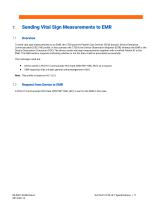
Sending Vital Sign Measurements to EMR To send vital sign measurements to an EMR, the CT50 uses the Patient Care Devices (PCD) domain, Device Enterprise Communication (DEC) IHE profile. In this scenario the CT50 is the Device Observation Reporter (DOR) whereas the EMR is the Device Observation Consumer (DOC).The device sends vital sign measurements together with a verified Patient ID to the EMR. The EMR sends a response indicating whether or not the data could be processed successfully. The messages used are: Device sends a PCD-01 Communicate PCD Data (ORU^R01^ORU_R01) as a request EMR...
Open the catalog to page 11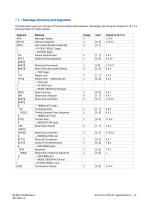
The table below gives an overview of the Device Observation Reporter messaging. See the given chapters in HL7 2.6 documentation for further details.
Open the catalog to page 12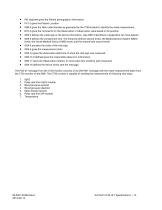
• PID segment gives the Patient demographic information • PV1-3 gives the Patient Location • OBR-4 gives the Filler order Number as generated by the CT50 module to identify the vitals measurement. • NTE-3 gives the comments for the Observation or Observation value based on its position. • OBX-3 defines the vitals sign or the device information. (see OBR-3 identifiers in AppendixA for more details) • OBX-4 defines the containment tree. The hierarchy defines several levels: the Medical Device System (MDS) levels, the Virtual Medical Device (VMD) levels, and the channel and source levels. •...
Open the catalog to page 14All SunTech Medical catalogs and technical brochures
-
Family of Blood Pressure Cuffs
12 Pages
-
Vet20 Brochure
5 Pages
-
Vet25 Brochure
5 Pages
-
oscar-2
5 Pages
-
OEM NIBP Advantage Brochure
4 Pages
-
OEM Solutions Brochure
4 Pages
-
Tango
1 Pages
-
Sun Tech Tango+ Stress BP
2 Pages
-
Sun Tech Disposable BP Cuffs
2 Pages
-
Sun Tech Durable BP Cuffs
2 Pages
-
SunTech Oscar 2 24-HR ABP
3 Pages



















